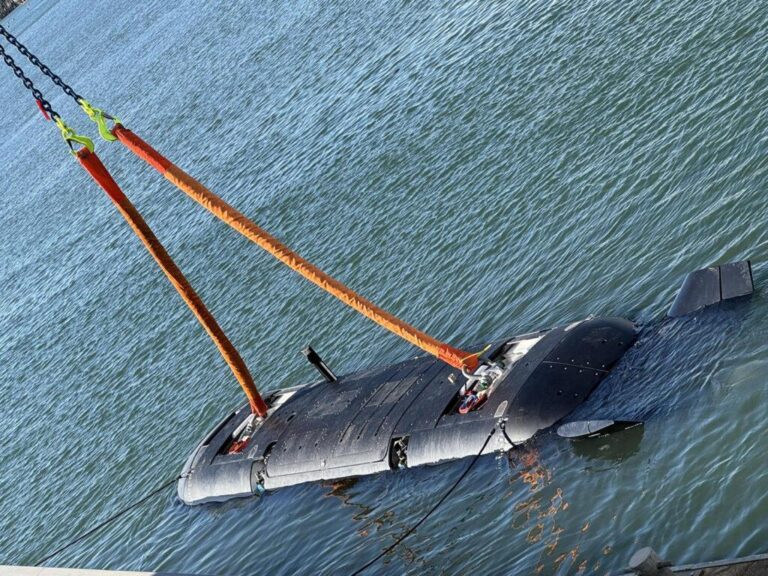In a significant advancement for the UKŌĆÖs naval capabilities, the CETUS XLUUV (Expendable Uncrewed Underwater Vehicle) has officially been launched by MSubs at its facility in Plymouth. This cutting-edge vehicle marks a pivotal step forward in the integration of unmanned systems within the Royal Navy, promising enhanced operational adaptability and increased safety for maritime missions. Designed for a variety of underwater tasks,the CETUS XLUUV is poised to revolutionize surveillance,reconnaissance,and other critical functions under the waves,as the UK seeks to strengthen its defense posture in an increasingly complex global maritime environment. With its advanced technology and versatility, the XLUUV not only reflects the UKŌĆÖs commitment to innovation in naval warfare but also positions MSubs as a key player in the future of underwater defense systems.
UKŌĆÖs CETUS XLUUV: A New Era in Uncrewed Underwater Vehicle Technology
The launch of the CETUS XLUUV marks a significant milestone in the evolution of uncrewed underwater vehicle technology, showcasing the UK’s commitment to advancing maritime capabilities. Developed by MSubs in Plymouth, this innovative vehicle is designed to enhance naval operations through its modular design and advanced functionality. With its cutting-edge technology, the CETUS XLUUV is capable of performing a wide range of missions, including:
- Intelligence Gathering: Collecting critical underwater data for strategic assessments.
- Surveillance Operations: Monitoring naval activities and securing maritime borders.
- Research Missions: Conducting environmental studies and marine research efficiently.
Equipped with autonomous navigation systems, the CETUS XLUUV is designed for extended missions, ensuring reliability in challenging underwater environments. It can be deployed in operations that demand both stealth and efficiency, giving naval forces a tactical advantage. The specifications of this remarkable vehicle are impressive, highlighting its capabilities:
| Feature | Description |
|---|---|
| Length | 15 meters |
| Speed | Up to 10 knots |
| Maximum Depth | 1000 meters |
| Operating Range | 1000 nautical miles |
Key Features and Capabilities of the CETUS XLUUV Unveiled in Plymouth
The CETUS XLUUV, unveiled at a recent event in Plymouth, boasts a wealth of advanced features that position it as a frontrunner in the unmanned underwater vehicle landscape. Key attributes include its autonomous mission capabilities, enabling long-duration operations without direct human oversight.The craft is designed for flexibility, easily adapting to a variety of mission profiles such as surveillance, reconnaissance, and environmental monitoring. Its innovative modular design allows for straightforward integration of various payloads, ensuring that operators can tailor the XLUUV’s functionalities to meet specific operational requirements.
Along with its versatility, the CETUS XLUUV is equipped with cutting-edge technology that enhances both its performance and safety. The vehicle features advanced navigation and interaction systems, enabling it to maintain situational awareness and respond to dynamic environments effectively. With a focus on durability and resilience,its construction incorporates high-strength materials,allowing it to endure challenging underwater conditions.The capabilities of the CETUS XLUUV are summarized in the table below:
| Feature | Description |
|---|---|
| Range | Extended operational range exceeding 1000 km |
| Payload Capacity | Up to 300 kg of customizable equipment |
| Speed | Maximum speed of 5 knots |
| Operating Depth | Capability to dive down to 1000 meters |
Strategic Implications and Future Applications of CETUS for Naval Operations
The launch of the CETUS, an Extra Large Uncrewed Underwater Vehicle (XLUUV) developed by MSubs, marks a significant shift in naval operations that could redefine the dynamics of maritime warfare.As navies globally seek to enhance their capabilities in underwater domains, CETUS provides a platform that can conduct a variety of missions while minimizing crew risk and operational costs. This innovation will likely lead to a greater emphasis on uncrewed technology in strategic military planning, including:
- Autonomous reconnaissance: Conducting surveillance in highly contested waters without direct human involvement.
- Mine detection and disposal: Sweeping for maritime threats while ensuring safety for personnel.
- Intelligence gathering: Extended missions for data collection in antagonistic environments.
Moreover, the implications of CETUS extend beyond immediate operational capabilities. Its modular design means that future applications can be tailored to specific missions, adapting to evolving threats. This adaptability could facilitate cooperative missions among allied forces, creating possibilities for joint exercises and operations, and fostering international collaboration. The foreseeable future may witness tactical roles such as:
- Force multiplication: Enhancing fleet capabilities by deploying swarms of uncrewed units in coordinated operations.
- Logistical support: Conducting resupply missions while reducing the risks associated with conventional vessels.
Final Thoughts
the launch of the UKŌĆÖs CETUS XLUUV by MSubs in Plymouth represents a significant milestone in the evolution of naval defense technology.As the Royal Navy continues to explore innovative solutions for modern maritime challenges,the CETUS platform stands out for its potential to enhance operational capabilities and ensure security in an increasingly complex geopolitical landscape. With its advanced features and autonomous capabilities, the CETUS XLUUV is set to redefine the role of unmanned systems in naval operations. As MSubs embarks on this new chapter, all eyes will be on the developments in the capabilities of this cutting-edge vessel and its implications for future naval engagements. As the defense sector continues to adapt, the CETUS XLUUV paves the way for a new era of underwater warfare.







